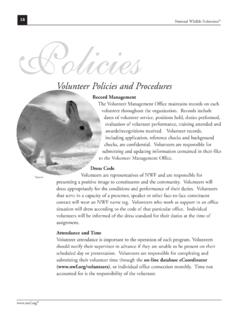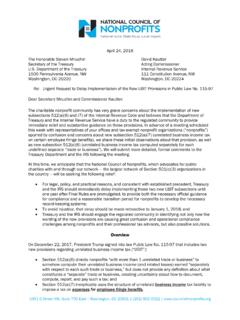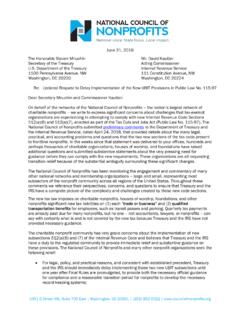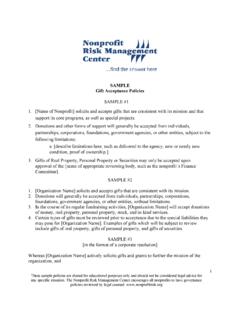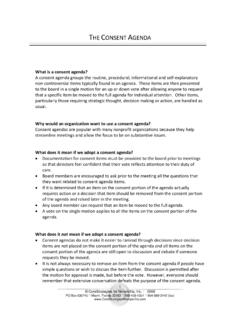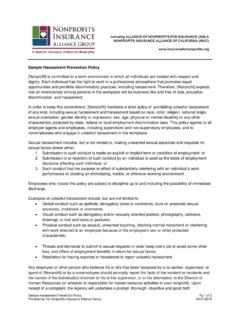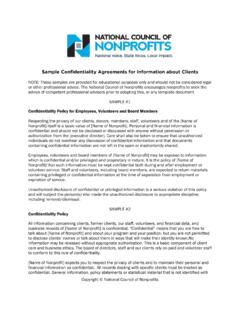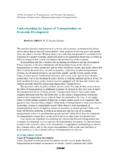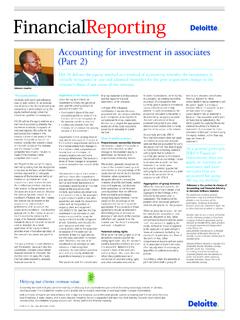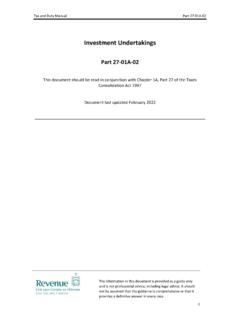Transcription of Investment Policy Sample - National Council of Nonprofits
1 Draft New York Council of Nonprofits 2014 1 ABC, Inc. Policy Number: ___ Investment Policy Date of Board Resolution: Purpose This Policy establishes Investment objectives, policies, guidelines and eligible securities related to all assets held by ABC, INC., and/or any of our subsidiary corporations, primarily for Investment purposes. ( institutional funds ) In doing so the Policy : clarify the delegation of duties and responsibilities concerning the management of institutional funds. identifies the criteria against which the Investment performance of the organization s investments will be measured. communicates the objectives to the Board, staff, Investment managers, brokers, donors and funding sources that may have involvement. confirms policies and procedures relative to the expenditure of institutional funds. serves as a review document to guide the ongoing oversight of the management of the organizations investments.
2 Delegation of Responsibilities The Board of Directors has a direct oversight role regarding all decisions that impact ABC, INC. s institutional funds. The Board has delegated supervisory responsibility for the management of our institutional funds to the (Oversight Committee Name). Specific responsibilities of the various bodies and individuals responsible for the management of our institutional funds are set forth below: Responsibilities of the Board The Board shall ensure that its fiduciary responsibilities concerning the proper management of ABC, INC. s institutional funds are fulfilled through appropriate Investment structure, internal and external management, and portfolio performance consistent with all policies and procedures. Based on the advice and recommendations of the (Oversight Committee Name), the Board shall: select, appoint and remove members of the Committee.
3 Approve Investment policies and objectives that reflect the long-term Investment -risk orientation of the endowment. Responsibilities of the (Oversight Committee Name) Members of the (Oversight Committee Name) are not held accountable for less than desirable outcomes, rather for adherence to procedural prudence, or the process by which decisions are made in respect to endowment assets. In consideration of the foregoing, the Committee is responsible for the development, recommendation, implementation and maintenance of all policies relative to ABC, INC. s institutional funds an shall: develop and/or propose Policy recommendations to the Board with regard to the management of all institutional funds. Draft New York Council of Nonprofits 2014 2 recommend long-term and short-term Investment policies and objectives for our institutional funds, including the study and selection of asset classes, determining asset allocation ranges, and setting performance objectives.
4 Determine that institutional funds are prudently and effectively managed with the assistance of management and any necessary Investment consultants and/or other outside professionals, if any. monitor and evaluate the performance of all those responsible for the management of institutional funds. recommend the retention and/or dismissal of Investment consultants and/or other outside professionals. receive and review reports from management, Investment consultants and/or other outside professionals, if any. periodically meet with management, Investment consultants and/or other outside professionals management, Investment consultants and/or other outside professionals. convene regularly to evaluate whether this Policy , Investment activities, risk management controls and processes continue to be consistent with meeting the goals and objectives set for the management of institutional funds.
5 Responsibilities of Management Management shall be responsible for the day-to-day administration and implementation of policies established by the Board and/or the (Oversight Committee Name) concerning the management of institutional funds. Management shall also be the primary liaison between any Investment consultants and/or other outside professionals that may be retained to assist in the management of such funds. Specifically, management shall: oversee the day-to-day operational Investment activities of all institutional funds subject to policies established by the Board and/or the (Oversight Committee Name). contract with any necessary outside service providers, such as: Investment consultants, Investment managers, banks, and/or trust companies and/or any other necessary outside professionals. ensure that the service providers adhere to the terms and conditions of their contracts; have no material conflicts of interests with the interests of ABC, INC.
6 ; and, performance monitoring systems are sufficient to provide the (Oversight Committee Name)with timely, accurate and useful information. regularly meet with any outside service providers to evaluate and assess compliance with Investment guidelines, performance, outlook and Investment strategies; monitor asset allocation and rebalance assets, as directed by the (Oversight Committee Name)and in accordance with approved asset allocation policies, among asset classes and Investment styles; and, tend to all other matters deemed to be consistent with due diligence with respect to prudent management of institutional funds. comply with official accounting and auditing guidelines regarding due diligence and ongoing monitoring of investments, especially alternative investments. Prepare and issue periodic status reports to the Board and the (Oversight Committee Name). Investment Considerations In accordance with ABC, INC.
7 S understanding of NYPMIFA, the (Oversight Committee Name) must consider the purposes of both ABC, INC. and our assets in managing and investing institutional funds. All individuals responsible for managing and investing ABC, INC. s institutional funds must do so in good faith and with the care that an ordinarily prudent person in a like position would exercise under similar circumstances. In making any decision relative to the expenditure of institutional funds, each of the following Draft New York Council of Nonprofits 2014 3 factors must be considered, and properly documented, in the minutes or other records of the applicable decision-making body: 1. general economic conditions; 2. possible effect of inflation or deflation; 3. expected tax consequences, if any, of Investment decisions or strategies; 4. the role that each Investment or course of action plays within the overall Investment portfolio of the fund; 5.
8 Expected total return from the income and appreciation of investments; 6. other resources of the organization; 7. the needs of the organization and the fund to make distributions and preserve capital; and, 8. an asset s special relationship or special value, if any, to the organization s purposes. Guidelines for Investing The Investment goal of the total return fund is to achieve a total return (income and appreciation) of 5% after inflation, over a full market cycle (3-5 years). The following guidelines apply to the three main Investment asset classes: Money Market Funds: Allowable range: Minimum 5%; Maximum 45% of total assets A quality money market fund will be utilized for the liquidity needs of the portfolio whose objective is to seek as high a current income as is consistent with liquidity and stability of principal. The fund will invest in money market instruments with remaining maturates of one year or less, that have been rated by at least one nationally recognized rating agency in the highest category for short-term debt securities.
9 If non-rated, the securities must be of comparable quality. Equities: Allowable Range- Minimum 20%; Maximum 60% of total assets The equity component of the portfolio will consist of high-quality equity securities traded on the New York, NASDAQ or American Stock exchanges. The securities must be screened for above average financial characteristics such as price-to-earnings, return-on-equity, debt-to-capital ratios, etc. No more than 5% of the equity portion of the account will be invested in any one issuer. As well, not more than 20% of the equity portion of the account will be invested in stocks contained within the same industry. It is acceptable to invest in an equity mutual fund(s) adhering to the Investment characteristics identified above, as long as it is a no-load fund, without 12(b)(1) charges, which maintains an expense ratio consistent with those other funds of similar Investment styles as measured by the Lipper and/or Morningstar rating services.
10 Prohibited equity investments include: initial public offerings, restricted securities, private placements, derivatives, options, futures and margined transactions. Exceptions to the prohibited Investment Policy may be made only when assets are invested in a Mutual Fund(s) that periodically utilizes prohibited strategies to mitigate risk and enhance return. Fixed Income: Allowable Range- Minimum 35%; Maximum 75% of total assets Draft New York Council of Nonprofits 2014 4 Bond investments will consist solely of taxable, fixed income securities that have an Investment -grade rating (BBB or higher by Standard & Poor s and Baa or higher by Moody s) that possess a liquid secondary market. If the average credit quality rating disagrees among the two rating agencies, then use the lower of the two as a guideline. No more that 5% of the fixed income portfolio will be invested in corporate bonds of the same issuer.
